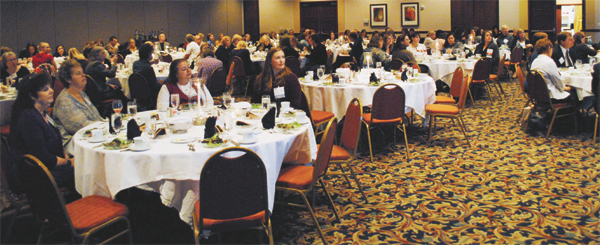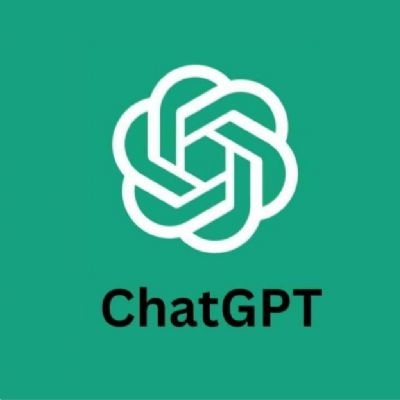Networking Groups Brought Tangible Benefits
PMA’s GADA Networking group, also consisting of top-ranking executives, has allowed Robert Laystrom, president of Laystrom Manufacturing Co., Chicago, IL, to develop professional and personal friendships with a core group of PMA members. “Those friendships have helped Laystrom Manufacturing and me personally,” he says.
For example, GADAs have helped Laystrom navigate the volatile steel market.
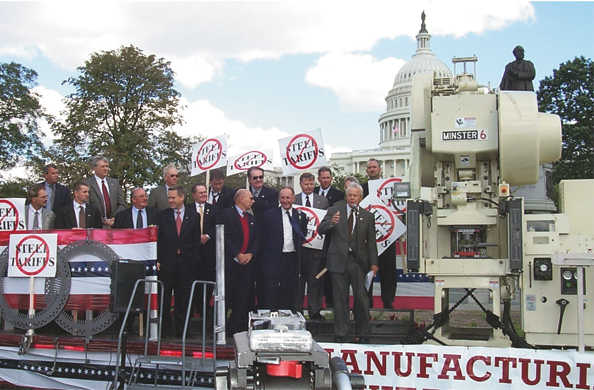 |
| PMA turned a corner in 2002, adopting advocacy as a means for getting the metalforming industry’s voice heard in Washington, D.C. The seminal event was a hearing on Capitol Hill in September of that year, to argue against Section 201 steel tariffs that were hurting the small- to mid-sized manufacturers that form the backbone of American industry. Besides testifying at the hearings, PMA members rallied in front of the U.S. Capitol (shown), even hauling in a stamping press on a flatbed truck to help make their point. |
“Steel prices als were pretty stable, but in the last decade commodity prices underwent a sea change and most of us did not know how to deal with that,” he recalls. “We went to the networking meeting thinking that we wouldn’t be able to pass along material-price increases. But a few members fought that notion, saying, ‘What kind of business are you going to be if steel prices rise 10, 20 or 30 percent and you can’t get it back?’ That opened our eyes, and is a perfect example of, when something changes in the industry, how the networking group helps us deal with it more quickly than if we would have to figure it out on our own.
“That reasoning regarding steel-price increases,” Hurst continues, “meant setting up relationships with customers that would allow us to pass through pricing, and also give back when prices on commodities drop. This model has worked pretty well—in this case the networking group probably saved our business.”
Like Laystrom, Erick Ajax, owner of E.J. Ajax and Sons, Minneapolis, MN, praises PMA’s GADA Group.
“The other GADA members have the same challenges that we do. Just recently, I had a question about intellectual property. Within an hour of sending my question out via the GADA e-mail listserve, I had seven or eight members from across the country come back with ideas.”
With PMA networking, adds Wes Smith, president of E & E Manufacturing Co., Plymouth, MI, “I’ve made many friends that have become customers and friendly competitors,” an observation echoed by James Zawacki, owner of GR Spring & Stamping Co., Grand Rapids, MI.
“We’ve become much more successful as a company due to membership in PMA,” Zawacki says. “Networking with PMA members has provided us with a strategic alliance; enabled us to purchase a captive tool shop, and offered access to best manufacturing practices from around the world.”
“My biggest customer today is Nissan,” Zawacki continues, recalling how his company’s strategic alliance in Mexico came about. “Back in 2004 we were growing rapidly, and Nissan called, wanting us to be in Mexico. Because of networking with PMA, I already knew of three U.S. companies with plants in Mexico, and with one of those we formed a strategic alliance. That helped us earn $5 million worth of new business, and helped our partner (Batesville Tool & Die, Batesville, IN, another long-time PMA member) as well.”
Zawacki says he probably has visited more than 200 PMA-member plants over the years, with officers from 100 PMA plants visiting GR Spring & Stamping in return.
“Seeing these operations either gives us new ideas or reinforces what we already are doing. Networking through PMA is key to our success. You don’t have to be smart, you just have to be smart enough to learn from others.”
Through networking, PMA has been the mechanism for diverse entities to confront common challenges.
“PMA has brought a lot of small, family-owned operations as well as medium-sized and large metalforming companies together to work on common issues as one, instead of as individuals, from training and compensation to legislative issues,” says Kent Djubek, president of E.J. Ajax and Sons. “The association has created a group of people with common interests who can talk about common issues. It’s hard to put a dollar value on our membership—it’s the intangibles, rubbing elbows with people from the industry with the same challenges.”
Nothing Beats Face-to-Face Contact
The advent of social networks and access to all sorts of information via the Internet has led some companies to question the value of an association as a means to network. Zierick doesn’t buy such views.
“I don’t care how many social-networking opportunities are out there, people get so much more out of face-to-face contact,” she says. “When PMA organizes an event—the Annual Meeting, Awards of Excellence, CEO Networking Group, Women in Manufacturing or any of the numerous roundtables or training sessions where members meet with other people dealing with similar challenges—the face-to-face interactions far surpass anything available off of the Internet. That is where PMA will continue to offer great value to members, by providing that personal contact.”
A Voice in Washington
PMA turned a corner in 2002, adopting advocacy as a means for getting the metalforming industry’s voice heard in Washington, D.C. The seminal event was a hearing on Capitol Hill in September of that year, to argue against Section 201 steel tariffs enacted earlier in 2002. The tariffs, argued PMA members, were hurting the small- to mid-sized manufacturers that form the backbone of American industry. Never before had such a group been formed to have its voice heard in Washington. Besides testifying at the hearings, PMA members rallied in front of the U.S. Capitol, even hauling in a stamping press on a flatbed truck to help make their point. Partnering with other trade associations, PMA was able to make a difference, as the Bush Administration decided to end the scheduled 3-yr. tariffs 16 months early. The action surrounding the tariffs galvanized the metalforming community, according to PMA members who lobbied, and set in motion a formal avenue for PMA members to have their voices heard in Washington, an avenue still traveled by the association today.
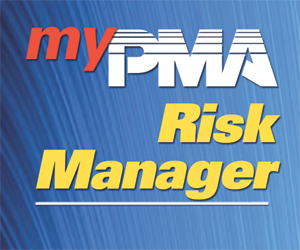 |
Over time PMA has developed training programs and educational tools to help metalforming operations of all sizes. A recently introduced product, PMA Risk Manager, forms the safety-program framework at several companies in the industry, including Laystrom Manufacturing.
“It has helped us organize safety activities, make safety materials more accessible to our employees, and improve the safety performance of our company,” says Bob Laystrom. |
“When President Bush enacted the 201 steel tariffs, the immediate impact to my bottom line was $6 million,” recalls Smith. “We were, as was everyone, forced to put a gun to the heads of our customers. However, the best and long-term solution was to get the government out of the steel business. PMA jumped to the front and led the charge that led to a repeal of the tariffs at the midpoint review. PMA has stayed in front and has became the voice not only of the metalforming industry, but for all small and medium-sized manufacturers.”
“That day on Capitol Hill was a big change in what PMA does, and I remember it vividly,” adds Ajax.
“Standing on the back of a flatbed truck in front of the U.S. Capitol with a punch press (provided by long-time PMA member McGregor Metalworking Companies, Springfield, OH), we were holding banners that read, ‘No Steel Tariffs.’ The police came along and asked us to politely put our banners down, but we had the permit for the truck to park in front of the U.S. Capitol.”
Advocacy Must Continue for U.S. Manufacturing to Thrive
That action sent a message not only to Congress and the administration, but also to PMA members and small and mid-sized manufacturers across the country.
“When you’re in D.C.,” explains Habe, “and I’ve gone a few times, you look at the agriculture business and see how they have a huge foothold and all of the funding—they can push the buttons. Manufacturing is a small entity. You would think we have a bigger presence but we don’t. But we are chipping at the block and starting to be heard. During one of his recent speeches, President Obama mentioned ‘manufacturing’ 25 times. Part of that is the constant message that we are here and without us you don’t have a middle class, which helps make this country strong. We have to collaborate with the government—not just the politicians, but we have to maintain a voice with agencies regarding regulations.”
Bottom line, according to Habe: “If it is going against your interests, you had better get out there and speak up.” Laystrom agrees.
“GE, Caterpillar, Ford, GM and other large manufacturers have a voice, and their views are adopted,” he says. “We little guys need to have a voice at the table as well. I’m optimistic about manufacturing’s future in the United States as long as PMA’s advocacy efforts can make things more even-handed on the regulatory side.”
Such efforts already have paid big dividends, according to Zawacki.
“PMA’s advocacy and lobbying programs have helped PMA members by saving thousands of manufacturing jobs in the United States,” he says, “and have led to policies that are beneficial to manufacturing—such as ending the steel tariffs and extending the R&D tax credit.
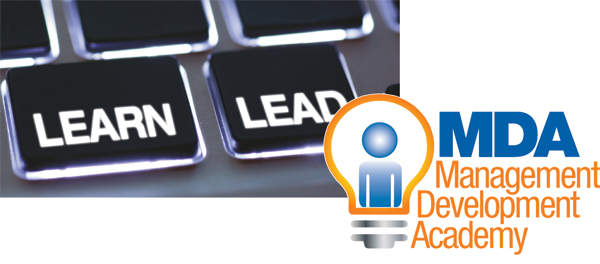 |
| PMA’s latest training initiative is the Management Development Academy (MDA). MDA, the brainchild of PMAs 2012 chairman P.J. Thompson, is a three-part series of forum-style workshops, instructional seminars and structured networking. It’s designed exclusively for middle-management professionals looking to advance their business and leadership acumen. |
“The association’s Capitol Hill visits give all of us a voice in D.C.,” Zawacki continues. “You begin to realize when you make these visits just how important they are. I remember my representative in Washington, D.C. saying, ‘Where are you guys? The opposition is at every one of my meetings, but I don’t hear enough from you. Even though I am on your side, it is nice to see the business owners.’
“I don’t care if your company is small or large,” Zawacki adds. “You have to be big enough to have a voice, and behind us we have the full power of PMA.”
Ajax also notes how it all began with the Section 201 tariffs, and the lessons learned then that guide PMA’s advocacy efforts today.
“PMA single-handedly lobbied to repeal the steel tariffs after our material prices went up overnight, making us uncompetitive in the global marketplace,” says Ajax. “We were up against the big steel lobby. PMA held a rally at E.J. Ajax that brought dozens of our competitors. We were on the front page of the Minneapolis and St. Paul newspapers, as well as on the front page of the New York Times. After the repeal, I met a steel lobbyist who told me, ‘You guys put up a good fight.’ They had millions of dollars against our tens of thousands of dollars, but we won—a David and Goliath battle.”
Training Makes the Difference
“We all can buy essentially the same equipment,” says Ajax, explaining U.S. competitiveness on a global stage, “but it comes down to the skill set that our colleagues have. We have the ability to create 20 times more value than do our competitors in China and India. And, of course, our colleagues earn 20 times what someone in China or India earns.”
That value creation requires training, and PMA and its Educational Foundation (PMAEF) have stepped to the plate over the years to deliver the training needed to help member companies succeed. In the 1980s, notes Zawacki, GR Spring & Stamping joined PMA to make training programs available to all of its associates, and has been an active member ever since.
“All GR Spring & Stamping associates have been exposed to PMA’s training programs, which are part of each employee’s orientation,” Zawacki says. “We would rather have a new associate without press experience be taught the proper to do things, than an experienced new hire come in with bad habits.”
Over time PMA has developed training programs and educational tools to help metalforming operations of all sizes. In the past few years PMA and PMAEF have further increased training offerings, making training the one PMA service that many members see as most beneficial, including Phoenix Specialty Manufacturing, according to Hurst.
Zierick Manufacturing, besides using PMA materials for press-operator and safety training, uses PMAEF material as a pre-employment test, according to Zierick. And, a recently introduced product, PMA Risk Manager, forms the safety-program framework at Laystrom Manufacturing.
“It has helped us organize safety activities, make safety materials more accessible to our employees, and improve the safety performance of our company,” says Laystrom.
The association has long been considered the one-stop shop for metalforming training.
“We joined PMA because we were looking for answers to training and education for punch-press operators,” recalls Djubek of E.J. Ajax and Sons. “Before PMA offered solutions to our training needs, we assumed the asociation was for bigger companies and wouldn’t be effective for us. Now, everyone in our company uses PMA products and services—because of the National Institute for Metalworking Skills (NIMS) credentialing and training programs that the PMA Educational Foundation helped to fund.”
Ajax echoes those sentiments.
“PMA has done some exceptional things in promoting professional development,” Ajax says, “especially being one of the funding partners of the NIMS credentialing program. That program has brought more credibility to apprenticeship training because it’s skills-based, rather than time-based. Also, we use a test that PMAEF put together, the Occupational Aptitude and Knowledge Assessment, for every hiring decision that we make— entry level and incumbent. Lastly, PMAEF has helped support and fund our punch-press metalforming program in the Twin Cities for more than a decade. Its educational and training support has had a big impact on metalforming in our region.”
Noting that E.J. Ajax and Sons first got involved with PMA due to its educational and leadership programs, Rob Duvall, the company’s director of training, says that another driving force for involvement was the work PMA’s Twin Cities district had been doing with education.
“It was a perfect relationship for us,” he says.
E & E Manufacturing Co. also takes advantage of the association’s training and safety products and services. In fact, Smith made development of training products for business leadership a priority during his tenure as PMA chairman in 2007.
“My message to PMA members and the entire stamping community,” said Smith upon taking the chairmanship, “was to focus on developing strategies that allow companies to operate with a strong balance sheet. The best companies are the ones that have figured out how to provide higher-profit products to their customers while reducing their customers’ costs.”
PMA members we talked to hope to see education efforts continue.
“Our industry’s lack of skilled workers will be a major obstacle for us in terms of global competition,” says Ajax. “More than half of PMA members and other employers simply can’t find qualified applicants that we need right now to fill existing openings. PMAEF can help support such efforts.”
PMA Targeting Mid-Level Employees
One goal is expanding involvement in PMA at levels below the senior managers, according to Laystrom.
“The challenge for PMA is to try to dig down into member organizations to bring in people such as purchasing agents and supervisors, not just owners and a few senior-level people,” he says. “The mid-level academy is a good start.”
Laystrom is referring to PMA’s latest training initiative, the Management Development Academy (MDA). MDA is a three-part series of forum-style workshops, instructional seminars and structured networking designed exclusively for middle-management professionals looking to advance their business and leadership acumen. The academy, which held its first of three 2012 training sessions in June, allows participants to learn practical skills and strategies about how to succeed when analyzing metalforming markets, conducting marketing research, managing assets and budgets, and developing and managing supply chains, financial and customer accounts, contracts and human resources.
In fact, middle-management training has been highlighted as a major association goal by P.J. Thompson, PMA’s 2012 Chairman and president of Trans-Matic Manufacturing Co., Holland, MI.
“We must shine the light on these key leaders within our companies, identify opportunities to train them, bring them into the forefront and empower them to help guide our companies forward,” Thompson says.
“If you can start developing two, three, four people in an organization,” reasons Laystrom, “who will come to PMA’s meetings, the association will continue to become more and more valuable to us all.”
PMA’s MetalForming Magazine Highlights Industry Technology
One PMA and its predecessor the American Metal Stamping Association (AMSA) have fostered technology transfer to membership and the industry is through its magazine, MetalForming. Consider this passage from Metal Stamping—which evolved into MetalForming—that appeared in the March 1967 issue:
“Technological change in the metal-stamping industry is going forward at an ever increasing pace. Those who are slow to adopt ideas and methods for improving quality and efficiency will be left behind by those who are more receptive to change.”
That was true in 1967, and it’s just as true today. Only the ideas and methods have changed. Back in the mid-1960s, few could imagine the profound effect developments in automation and controls, materials and process equipment would have. Add to that the bevy of management philosophies and the advent of regulations following the formation of OSHA and EPA, and the landscape now traveled by metalformers would scarcely be recognized by their ancestors. Not to mention the creation of ISO and related quality systems. Today, MetalForming magazine takes advantage of communication and media advances to offer information to the industry in a variety of formats, not just in a monthly print publication but 24/7 worldwide through the Internet.
“MetalForming magazine allows our associates to stay informed and up to date on the latest technologies and techniques,” explains Mark Cross, responsible for sales, marketing and special projects at metal stamper PTM Corp., Fair Haven, MI. Cross notes that the magazine is the one PMA service he would not want to do without.
“The magazine is in wide distribution throughout our buildings. I think it adds great value. The technical articles keep our designers and tool builders thinking and fresh.” MFIndustry-Related Terms: Case,
Core,
Corner,
Die,
Draw,
Form,
Model,
Plate,
Punch Press,
Run,
TransferView Glossary of Metalforming Terms
See also: Precision Metalforming Association
Technologies: Management, Training
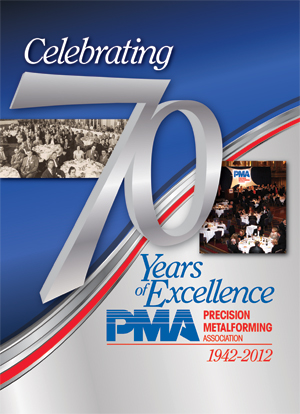 Through its 70 years, the Precision Metalforming Association (PMA) and its predecessor, the American Metal Stamping Association, have enabled members to network with peers, witness new technologies through publications and tradeshows, benchmark operations against best-in-class manufacturers, avail themselves of industry statistics, and learn new s to efficiently produce quality parts.
Through its 70 years, the Precision Metalforming Association (PMA) and its predecessor, the American Metal Stamping Association, have enabled members to network with peers, witness new technologies through publications and tradeshows, benchmark operations against best-in-class manufacturers, avail themselves of industry statistics, and learn new s to efficiently produce quality parts.  “Through networking via PMA, the industry has been able to open up and share ideas,” says Lisa Habe, president of Interlake Industries, Inc., Willoughby, OH. “In the past, manufacturers tended to be more silent about their businesses.”
“Through networking via PMA, the industry has been able to open up and share ideas,” says Lisa Habe, president of Interlake Industries, Inc., Willoughby, OH. “In the past, manufacturers tended to be more silent about their businesses.”